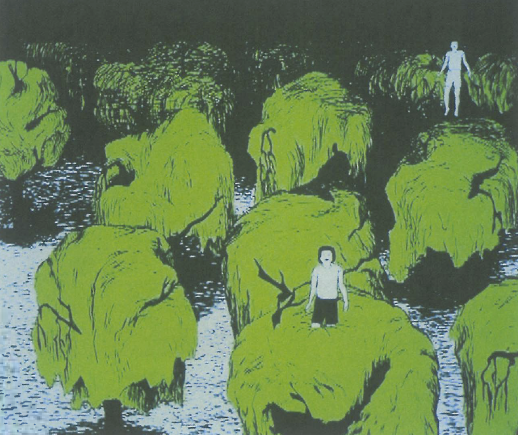
Earlier this year, ACCA director Juliana Engberg lamented the lack of co-ordinated effort between Melbourne's key public galleries. She thought the director of the National Gallery of Victoria should be talking to her about exhibition tie-ins. The latest show at ACCA, New 04, might give us some clues as to why Gerard Vaughn does not appear to have been in a rush to return Engberg's calls.
That outstanding young artists are getting gigs is a good thing. They need to be encouraged: after all, many do interesting stuff. And it is a comfort to the reviewer that criticism will be harmless, for careers are well established by the time they get to ACCA.
Part of the brief for New is the development of curatorial practice, and the catalogue is a first-rate job. Well produced, good photography, good design (based on the previous year), texts that give the best possible spin on the art. The writing talent is impressive. The manufacture of silk purses from sows' ears has long been a staple of the catalogue essay (I refer the reader to Umberto Eco's essay 'How to write an Introduction to an Art Exhibition' in How to Travel with a Salmon), and the scribes have shown that they are more than up to the task.
Apart from the curator's catalogue blurb and the fact that all concerned hail - at some stage - from Melbourne, there's not a lot tying the pieces together. This catholic range may be a strength of the show, as the artists variously tackle installation and performance (recorded) along with object art and painting.
The first room contains works that are conceptually more or less opposed. Tower Case (Home is where the hard drive is) by Stephen Honegger & Anthony Hunt, weighs in for object art. A giant model of a computer case, a homage to generic design of a couple of decades ago, it puts us in mind of the oeuvre of Claes Oldenburg, except, of course, that this particular subject for rescaling didn't exist when he kicked off the giantism thing.
At the other end of the room is Tom Nicholson's Seven Days, an installation of large banners, larger video projections, and book layout negatives more or less explaining the project. The artist, we are informed, dislikes didactic art, but this work seems to fit quite well within a rubric. The whole thing revolves around the notions of borders and identity. Disputed lines between nations are mapped out as walks through various parts of Melbourne. A video loop shows seven banner processions following these routes. The banners bear closely cropped images of faces in a kind of half-tone. All this business is presented in the gallery, and, despite the charm of the banners themselves, the total effect is somewhat strained.
Between these works Sangeeta Sandrasegar's ...and she spins and weaves with them still, and continues to hang makes effective use of paper cut-out, a medium which has gained some favour of late. Spiders decorate the sides of a shrine-like structure. Within, an elaborate lantern casts shadows on the walls. The lantern is cut into the figure of a young woman, her hair streaming out into small vignettes and into the hands spinning these scenes. The influence of manga imagery is apparent, not the least in the tear streaming down the heroine's cheek.
Parekohai Whakamoe's There He Is pushes the investigation of identity further, with four animations on mythic lines- the Guide, the Warrior, et al. Projected on to a wall in a room populated with tree branches reaching from floor to ceiling, these images put one in mind of a segment of Eat Carpet viewed in a burnt forest. The limitations of the flash animation employed here detracted from the effect of gravitas intended.
Gravity definitely played a part in Guy Benfield's Om SupremeBhagwan (Demonstration Werk) in the next room. There is nothing quite like seeing a video of a chap hauling around a bearded skull dripping paint, especially when the funnel planted into the cranium bears the legend 'Mother' -so cute. The video and installation is the sort of thing Quentin Tarantino might have put into Kill Bill 1 had he needed a performance art scene. Catalogue notes tell us that Benfield spent a decade '&unlearn(ing) the crap he had been taught at the VCA', and all the evidence is that the effort paid off: the artist is currently on a Samstag scholarship.
Of all the work exhibited, Nadine Christensen's It's been a long time longing is perhaps the most convincing. Seagrass matting and a rocking chair do not make a room of paintings an installation, but the images, low-tech and generally muted, show disquiet and skill. Her paint-by-numbers technique and its products, landscapes that reek of alienation, together reveal a cool, ironical sense.
The most significant irony, however, lies in the claims made for New 04. If this selection really represents the best talent in town, then the Melbourne art scene may not be quite as vibrant as it's cracked up to be. Perhaps ACCA's curators ought to poke around some more studios. In one of Christensen's paintings a mobile phone, lead attached, sits on a table before a desolate scene. Perhaps there are others still waiting for the call.












